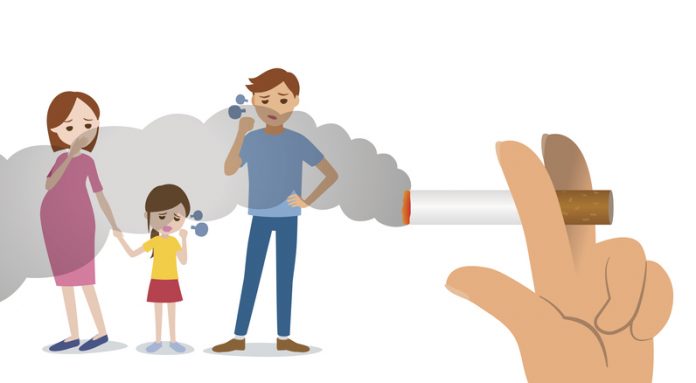Here’s how smoking harms the heart, clots blood and causes brain strokes

- Reporter 02
- 24 Aug, 2022
A recent publication in the medical journal Lancet reported that 44.4 per cent of global cancer deaths are attributable to three risk factors — smoking, excessive alcohol consumption and a high body mass index (BMI) which indicates overweight or obesity. Each of these is related to unhealthy behaviour, propelled by commercial drivers, which prioritise profits over people’s health.
The tobacco industry trades in death and disease, as more than 25 diseases are linked to active or passive exposure to the noxious chemicals that enter the human body from smoked or chewed tobacco products. The industry has vigorously fought against regulatory measures to control it. When it can no longer derail, delay or dilute regulatory measures, it introduces new products to entice and entrap young persons wearing the veil of “harm reduction.” Vaping is one such form being promoted by the tobacco industry.
It is necessary, therefore, to keep informing people about the harm to health from tobacco consumption. Apart from the well-recognised relationship to a variety of cancers, damage to heart and blood vessels can be severe. Indeed, a greater number of tobacco victims die globally from cardiovascular diseases than from cancers. There are many ways in which tobacco consumption, active or passive, can harm the heart, arteries and veins.
Smoked tobacco releases several chemicals. Of these, nicotine and carbon monoxide are especially harmful to blood vessels. Nicotine constricts the blood vessels and reduces blood flow. Carbon monoxide is highly injurious to the blood vessel wall. A variety of oxygen-free radicals generated during smoking also damage the blood vessels.
Tobacco use promotes both atherosclerosis (fat deposition coupled with fibrosis) in the vessel walls and thrombosis (blood clot formation) on the damaged vessel walls. Composition and levels of blood fats are affected by smoking. Blood levels of HDL cholesterol (the protective fraction) are decreased while the levels of the highly atherogenic “small dense LDL” fraction increase. Triglyceride levels too rise in the blood. Smoking has also been linked to an increased risk of diabetes and pre-diabetes, which are associated with an increased risk of heart attacks.
When the walls of blood vessels are inflamed, their protective inner lining (the endothelium) is breached. Blood fats get deposited in these damaged areas. Those deposits grow into plaques, with accompanying fibrosis. The plaques continue to grow with time. When large, they can impede blood flow, through mechanical obstruction. This may manifest as angina (chest pain) on exertion, often presaging a heart attack.
HOW SMOKING UPS CLOTTING
Smoking also activates a cascade of proteins (clotting factors), leading to the formation of blood clots. It causes platelets (blood cells that form a clot) to clump together. The atheromatous plaques, even when small, can be destabilised by smoking. As they crack open in any arterial wall, their exposed fatty core initiates clotting of blood flowing in those arteries. When this happens, large clots can quickly form and block blood flow completely. This can lead to a heart attack, which may permanently damage the heart muscle or even kill the person. When a plaque is soft, smoke from even a single cigarette can cause plaque instability, precipitating a heart attack.
AGE FACTOR AND HEART RISK
Smokers get a heart attack 7-10 years earlier than non-smokers. Male smokers have a two-fold higher risk of heart attacks than non-smokers. Women smokers have a three to four fold higher risk of heart attacks than non-smoking peers, because smoking diminishes the protective effect of female sex hormones. Risk of heart attacks in women smokers is greatly magnified if they are also consuming oral contraceptive pills.
TOBACCO CAUSES ARRHYTHMIA
Tobacco products also cause irregularity of heart beat. While ectopics (missed beats) are common, life threatening electrical disturbances (arrhythmias) too can be triggered. Sudden cardiac death is ten times more common in smokers than in non-smokers. Young smokers succumbing to sudden death, even when only a single coronary artery has been affected, has often been observed. This is due to large clots blocking blood flow.
HOW SMOKING INDUCES BRAIN STROKES
Risk of strokes (brain attacks) too increases because blood clots can form more readily in the blood vessels of tobacco users. These clots cut off blood supply to parts of the brain. By acutely raising blood pressure, smoking increases the risk of sub-arachnoid haemorrhage (a type of brain bleed into the surrounding fluid). Aorta, the main artery that arises from the heart to distribute blood to all parts of the body through its branches, can balloon in parts (aneurysm) and rupture. Disease of arteries of the legs can lead to gangrene and amputation. Even the large veins can suffer from clots. Blood flow through the maternal placenta is reduced as arteries constrict due to active or passive exposure to tobacco smoke, thereby increasing the risk of still births or small sized babies. Endothelial dysfunction of the arteries supplying blood to the male genitalia causes impotence (erectile dysfunction).
Passive smoking too damages the heart and blood vessels. Studies have shown that arteries of otherwise healthy young male smokers have impaired ability to dilate when needed (endothelial dysfunction). This can set the stage for early atherosclerosis and future heart attacks. Indeed, women and men who are frequently exposed to second-hand smoke have been shown to have a higher risk of heart attacks, compared to those who have low exposure.
With such a wide range of harmful effects on the heart and blood vessels, tobacco must be regarded as a major threat to human health. It is essential that young people, who are attracted to tobacco products, are made fully aware of the harmful consequences of their use. Even adult smokers too should be encouraged to quit. Stopping tobacco consumption halves cardiovascular risk within a year and practically nullifies it by the third year. Deferring the decision to stop can be fatal, as sudden cardiac death can strike without warning. It will be a pity if life goes out in a puff of smoke.
Even as we are engaged in combating a Covid pandemic which refuses to fade away, it is important for us to recognise that tobacco still remains a constant threat to global health. The annual global death toll from tobacco has crossed 8 million. While there have been some successes in reducing the prevalence of tobacco consumption over the past two decades, in India and many parts of the world, tobacco products continue to endanger many millions in the growing global population.
Leave a Reply
Your email address will not be published. Required fields are marked *











